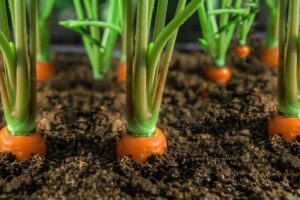Introduction: Growing your own carrots can be a rewarding and satisfying experience, providing you with fresh and flavorful produce right from your garden. Whether you’re a seasoned gardener or a novice with a green thumb, this comprehensive guide will walk you through the step-by-step process of cultivating delicious carrots in your backyard.
The Nutritional Profile:
Carrots boast an impressive nutritional profile that makes them a valuable addition to any diet. They are a rich source of vitamins, minerals, and dietary fiber, making them a versatile and healthful choice.
Vitamins: Carrots are particularly known for their high vitamin A content, primarily in the form of beta-carotene, which gives them their vibrant orange color. Vitamin A is essential for maintaining good vision, a healthy immune system, and proper skin health. Additionally, carrots contain vitamins C, K, and B6, contributing to immune support, blood clotting, and overall well-being.
Minerals: These root vegetables are a great source of minerals like potassium, which supports heart health and helps maintain proper fluid balance in the body. They also contain small amounts of calcium, magnesium, and phosphorus, all of which play important roles in bone health and muscle function.
Dietary Fiber: Carrots are an excellent source of dietary fiber, aiding in digestion and promoting a feeling of fullness. The fiber content also supports gut health by acting as a prebiotic, nourishing beneficial gut bacteria.
Selecting the Right Carrot Varieties:
Before you begin cultivating carrots, it’s essential to choose the right variety for your growing conditions and preferences. Common types include Nantes (cylindrical and sweet), Imperator (long and slender), and Chantenay (short and stout). Additionally, you can explore colorful varieties like purple and yellow carrots for added visual appeal.
Preparing the Soil:
Carrots thrive in loose, well-draining soil with plenty of organic matter.
Choose the Right Location: Carrots prefer full sun but can tolerate partial shade. Choose a spot in your garden that gets at least 6-8 hours of sunlight daily.
Soil Testing: Test your soil to determine its pH level. Carrots prefer slightly acidic to neutral soil with a pH range of 6.0 to 7.0.
Amend the Soil: Incorporate organic matter like compost or well-rotted manure into the soil to improve its fertility and structure.
Loosen the Soil: Carrots need loose, friable soil to grow straight and unobstructed. Remove rocks, roots, and debris, and use a garden fork or tiller to break up compacted soil.

Planting Carrot Seeds:
Carrots are usually grown from seeds rather than transplants. Follow these steps for successful planting:
Seed Spacing: Carrot seeds are tiny, so they need to be spaced carefully. Sow seeds about ¼ to ½ inch deep and 2-3 inches apart in rows. Space rows 12-18 inches apart.
Thinning: Once your carrot seedlings are about 2-3 inches tall, thin them to ensure proper spacing. Leave 2-3 inches between each seedling.
Watering and Thinning:
Maintain consistent moisture during the germination period, which typically takes 1-3 weeks. Be careful not to over water as the seeds will rot. Once the seedlings have sprouted and grown a couple of inches tall, thin them out to provide adequate space for each carrot to develop. Space between plants should be 2-3 inches.
Fertilization:
Carrots are relatively light feeders, but they still benefit from a balanced fertilizer application. Apply a balanced fertilizer according to the manufacturer’s instructions when the carrot foliage is about 3-4 inches tall. Avoid using excessive nitrogen, as this can lead to lush foliage but stunted roots.
Pest and Disease Management:
Monitor your carrot plants for signs of pests like aphids, carrot rust flies, and nematodes. You can use natural remedies like neem oil or introduce beneficial insects to control pest populations. Proper spacing and well-drained soil can also help prevent certain diseases like root rot.
Harvesting:
The moment of truth arrives when it’s time to harvest your homegrown carrots:
Timing: Carrots are usually ready for harvest 60 to 80 days after planting, depending on the variety. Check the seed packet for specific detail information.
Signs of Readiness: Carrots are ready to be harvested when their tops are about 1/2 inch in diameter. Gently pull the carrot up and check its size and color. They should have a vibrant color and a firm texture.
Harvesting Technique: To harvest, grasp the carrot’s foliage near the top of the root and gently pull while wiggling the root. If the soil is compacted, use a fork to loosen the soil before pulling.
Storing Your Harvest:
After harvesting, remove the tops of the carrots to prevent them from drawing moisture from the roots. Store your carrots in a cool, humid environment to keep them fresh. You can store them in the refrigerator or in a root cellar with sand or sawdust to maintain their quality for several months.
Health Benefits:
Eye Health: The beta-carotene in carrots is converted into vitamin A in the body, which is important for maintaining good vision. Vitamin A helps prevent night blindness and contributes to the overall health of the eyes.
Heart Health: The potassium in carrots supports heart health by helping to regulate blood pressure and maintain proper heart rhythm. The fiber content also contributes to cardiovascular health by reducing cholesterol levels.
Skin Health: The vitamins and antioxidants in carrots play a role in maintaining healthy skin. Vitamin A, in particular, supports skin cell production and repair, contributing to a glowing complexion.
Weight Management: The dietary fiber in carrots promotes satiety, making them a great snack for those looking to manage their weight.
Conclusion
The carrot, with its vibrant color and numerous health benefits, is truly a nutritional powerhouse. From supporting eye health to aiding digestion and promoting heart health, this root vegetable deserves a place on your plate. Whether enjoyed raw as a snack or incorporated into various dishes, carrots offer a tasty and nutritious way to enhance your diet and overall well-being. Growing carrots can be a gratifying experience that allows you to reconnect with nature and enjoy the fruits (or in this case, vegetables) of your labor. With the right variety, soil preparation, care, and attention to detail, you can cultivate a bountiful crop of nutrient-rich carrots that will not only enhance your culinary creations but also deepen your appreciation for the wonders of gardening.


